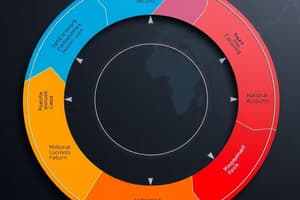Podcast
Questions and Answers
What does macroeconomics primarily focus on?
What does macroeconomics primarily focus on?
- International stock market performance
- Aggregate variables like national income and employment (correct)
- Individual household behavior
- Micro-level economic indicators
Which of the following is NOT an interaction examined by macroeconomics?
Which of the following is NOT an interaction examined by macroeconomics?
- Government and international trade
- Households and businesses
- Firms and households (correct)
- Government and businesses
In the circular flow diagram, what do households provide to firms through the markets for factors of production?
In the circular flow diagram, what do households provide to firms through the markets for factors of production?
- Investments and savings
- Goods and services
- Factors of production like labor, land, and capital (correct)
- Money and profits
What do firms pay to households for their supply of factors of production in the circular flow model?
What do firms pay to households for their supply of factors of production in the circular flow model?
How do households use the income they receive in the circular flow model?
How do households use the income they receive in the circular flow model?
What does the circular flow diagram illustrate about economic activities?
What does the circular flow diagram illustrate about economic activities?
What is the key difference between GDP and GNP?
What is the key difference between GDP and GNP?
Which approach to calculating GDP involves summing up value added at various production stages?
Which approach to calculating GDP involves summing up value added at various production stages?
What is the main purpose of adjusting nominal GDP for inflation to obtain real GDP?
What is the main purpose of adjusting nominal GDP for inflation to obtain real GDP?
Which type of inflation is characterized by expectations of future price increases?
Which type of inflation is characterized by expectations of future price increases?
How does inflation impact savings, investments, and financial planning?
How does inflation impact savings, investments, and financial planning?
Which factor is NOT a cause of inflation as mentioned in the text?
Which factor is NOT a cause of inflation as mentioned in the text?
Flashcards are hidden until you start studying
Study Notes
Macroeconomics
- Macroeconomics studies the overall performance and behavior of an entire economy.
- It focuses on aggregate variables such as national income, employment, inflation, and economic growth.
- It examines the interactions between households, businesses, government, and international trade.
Circular Flow Diagrams
- The circular flow model illustrates how money, goods, and services move between different sectors in an economy.
- Households provide factors of production (labor, land, and capital) to firms through the markets for factors of production.
- Firms use these factors to produce goods and services, which are sold in the markets for goods and services.
- Households purchase goods and services from firms through the same market for goods and services.
- Firms pay wages, rent, and profit to households for their supply of factors of production.
- Households use this income to spend on goods and services supplied by firms.
National Income
- Gross Domestic Product (GDP): The market value of all final goods and services produced within a country's borders during a specific period.
- Gross National Product (GNP): The total income earned by a country's residents (including those abroad) from all economic activities.
- Methods of calculating GDP:
- Expenditures Approach: Adds up spending on final goods and services (consumption, investment, government spending, exports, and imports).
- Income Approach: Adds up all income earned within the country (wages, rents, interest, profits).
- Value-Added Approach: Sums up value added at various production stages.
- Nominal GDP: Measures GDP using current prices.
- Real GDP: Adjusts nominal GDP for inflation, providing a more accurate picture of economic growth.
Inflation
- Inflation: The sustained increase in the general price level of goods and services over time.
- It erodes purchasing power and affects the cost of living.
- Causes:
- Demand-pull inflation (excessive demand).
- Cost-push inflation (rising production costs).
- Built-in inflation (expectations of future price increases).
- Effects:
- Redistributes income and wealth.
- Impacts savings, investments, and financial planning.
Studying That Suits You
Use AI to generate personalized quizzes and flashcards to suit your learning preferences.




